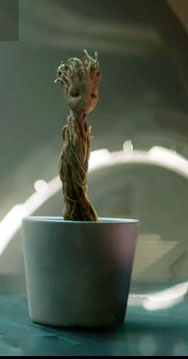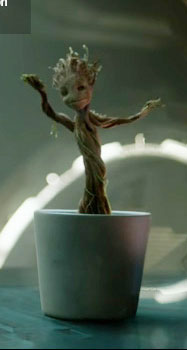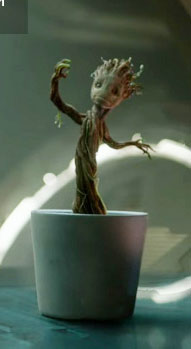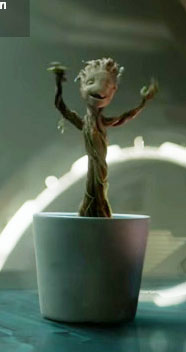When the film Guardians of the Galaxy opened during the summer of 2014, it rocketed up the box office returns as the “feel good” movie of the season. A light-hearted story, in the sense that it lifts one’s spirits and feelings, the film generated fast and positive word-of-mouth.
Groot As Supporting Character
 One element that contributed to this good feeling is the character of the alien Groot. Groot is, apparently, a sentient and mobile tree, and who only says “I am Groot” in various ways. At first, he just seems to be a quirkly, colorful background element to the story. But as the story builds to its climax, Groot becomes more and more important to the success of the quest of the principal characters. At a climactic moment, he sprouts branches to create a protective nest for his companions to shelter them from a terrible explosion. It blows him to shreds, but saves the others.
One element that contributed to this good feeling is the character of the alien Groot. Groot is, apparently, a sentient and mobile tree, and who only says “I am Groot” in various ways. At first, he just seems to be a quirkly, colorful background element to the story. But as the story builds to its climax, Groot becomes more and more important to the success of the quest of the principal characters. At a climactic moment, he sprouts branches to create a protective nest for his companions to shelter them from a terrible explosion. It blows him to shreds, but saves the others.
And then a twig is found, that has a budding face of Groot, which when planted proceeds to grow, promising the return of the appealing character.
43 Seconds of Joy
 After the filmmakers wrapped up the basic plotlines of the film, they added a little scene that shows the small Groot planted in a pot on a counter, while Drax cleans and sharpens a knife nearby. The music of the Jackson 5 kicks in, and “Baby Groot” (as fans quickly dubbed the sprout) starts dancing to it. He freezes at one moment when Drax looks around, but once Drax turns back to his personal chore, Groot joyfully gives in to the music.
After the filmmakers wrapped up the basic plotlines of the film, they added a little scene that shows the small Groot planted in a pot on a counter, while Drax cleans and sharpens a knife nearby. The music of the Jackson 5 kicks in, and “Baby Groot” (as fans quickly dubbed the sprout) starts dancing to it. He freezes at one moment when Drax looks around, but once Drax turns back to his personal chore, Groot joyfully gives in to the music.
The marketing folks at Marvel Studios (or parent company Disney) were savvy enough to recognize that these 43 seconds would be very popular. They beat the pirates to the punch and uploaded the clip of Dancing Groot to YouTube as soon as the movie opened. It promptly went viral online.
Why a Successful Quest Is Not Enough
 Would the film has been as successful without those 43 seconds? Probably, as it was filled with humor, intelligence, and the upholding of admirable virtues. These are all things that actually have a strong appeal to people. In spite of so much dark, cynical entertainment that does well in the marketplace, the audience does respond strongly to up-beat, positive, admirable material. So, when our heroes succeed in defeating the Bad Guy and “saving the world,” we are pleased and satisfied. And many stories would end with that and do well enough.
Would the film has been as successful without those 43 seconds? Probably, as it was filled with humor, intelligence, and the upholding of admirable virtues. These are all things that actually have a strong appeal to people. In spite of so much dark, cynical entertainment that does well in the marketplace, the audience does respond strongly to up-beat, positive, admirable material. So, when our heroes succeed in defeating the Bad Guy and “saving the world,” we are pleased and satisfied. And many stories would end with that and do well enough.
The added moment, those delightful 43 seconds, provides the final chord of the emotional composition of the story. We need that brief moment that provides emotional punctuation to the overall nature of the story.
Recovery Through Joy
 We want this pause that makes us rejoice in life. It fills out our satisfaction with the successful quest. Instead of ending with a plain “Yay! We did it!” the filmmakers give us a celebration of the character of Groot and simple enjoyment of the aftermath of success. Watching the sprouting Groot engage with the music carries the audience forward. We have watched Groot go from ominous and mysterious protector to Rocket Raccoon, to surprising helper, fierce warrior, and finally sacrificial savior of his companions. That progression is powerful enough on its own. To find that he is not totally lost, and indeed has gained this joyful expressiveness, gives the audience a sense of recovery.
We want this pause that makes us rejoice in life. It fills out our satisfaction with the successful quest. Instead of ending with a plain “Yay! We did it!” the filmmakers give us a celebration of the character of Groot and simple enjoyment of the aftermath of success. Watching the sprouting Groot engage with the music carries the audience forward. We have watched Groot go from ominous and mysterious protector to Rocket Raccoon, to surprising helper, fierce warrior, and finally sacrificial savior of his companions. That progression is powerful enough on its own. To find that he is not totally lost, and indeed has gained this joyful expressiveness, gives the audience a sense of recovery.
Recovery, restoration, and resurrection – these have considerable emotional power for the audience. Many people feel that they have lost key things in their lives, so recovery is an uplifting story element. Having something they have come to value restored to them, in some fashion or other ends a story on a very positive, satisfying note.
When winding down your story, consider this aspect of the ending. Everything has been wound up. The quest has been successful. Take a moment to celebrate, to be joyful about the achievement in some fashion.
